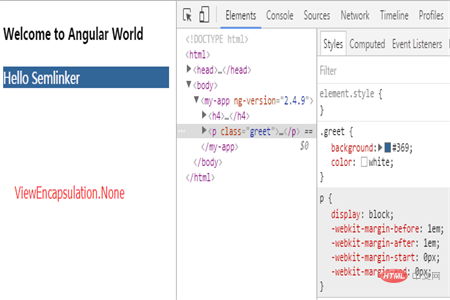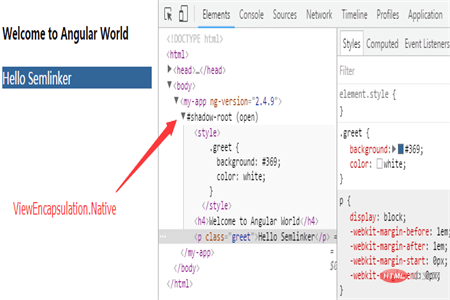
- 0133技术站
- 联系QQ:18840023
- QQ交流群

- 微信公众号


ViewEncapsulation 简介
在介绍 ViewEncapsulation 之前,我们先来介绍一下 Web Components 标准。
Web Components
近年来,Web 开发者们通过插件或者模块的形式在网上分享自己的代码,便于其他开发者们复用这些优秀的代码。同样的故事不断发生,人们不断的复用 JavaScript 文件,然后是 CSS 文件,当然还有 HTML 片段。但是你又必须祈祷这些引入的代码不会影响到你的网站或者 Web App。
Web Components 是解决这类问题最好的良药,它通过一种标准化的非侵入的方式封装一个组件,每个组件能组织好它自身的 HTML 结构、CSS 样式、JavaScript 代码,并且不会干扰页面上的其他元素。
Web Components 由以下四种技术组成:
Custom Elements - 自定义元素
HTML Templates - HTML模板
Shadow DOM - 影子DOM
HTML Imports - HTML导入
因为 Shadow DOM 与 Angular ViewEncapsulation 相关, 所以这篇文章我们主要介绍 Shadow DOM 相关的内容。
Shadow DOM
<!DOCTYPE html>
<html lang="en"><head>
<meta charset="UTF-8">
<title>Shadow DOM</title>
<style type="text/css">
.shadowroot_son {
color: #f00;
}
</style>
</head>
<body>
<p class="shadowroot_son">我不在 Shadow Host内</p>
<div class="shadowhost">Hello, world!</div>
<script>
// 影子宿主(shadow host)
var shadowHost = document.querySelector('.shadowhost');
// 创建影子根(shadow root)
var shadowRoot = shadowHost.createShadowRoot();
// 影子根作为影子树的第一个节点,其他的节点比如p节点都是它的子节点
shadowRoot.innerHTML = '<p class="shadowroot_son">我在 Shadow Host内</p>';
</script>
</body>
<html>
以上代码成功运行后,如下图:
我们发现在 #shadow-root 中的元素,不受我们外界定义的 CSS shadowroot_son 类影响。因此我们可以利用 Shadow DOM 来封装我们自定义的 HTML 标签、CSS 样式和 JavaScript 代码。需要注意的是 Shadow DOM 兼容性还不是很好。
接下来我们开始介绍 Angular ViewEncapsulation Modes:
ViewEncapsulation
ViewEncapsulation 允许设置三个可选的值:
ViewEncapsulation.Emulated : 无 Shadow DOM,但是通过 Angular 提供的样式包装机制来封装组件,使得组件的样式不受外部影响。这是 Angular 的默认设置。
ViewEncapsulation.Native :使用原生的 Shadow DOM 特性
ViewEncapsulation.None : 无 Shadow DOM,并且也无样式包装
ViewEncapsulation 枚举定义:
export enum ViewEncapsulation {
Emulated, // 默认值
Native,
None
}ViewEncapsulation.None
import { Component, ViewEncapsulation } from '@angular/core';
@Component({
selector: 'my-app',
template: `
<h4>Welcome to Angular World</h4>
<p class="greet">Hello {{name}}</p> `,
styles: [`
.greet {
background: #369;
color: white;
}
`],
encapsulation: ViewEncapsulation.None // None | Emulated | Native
})
export class AppComponent {
name: string = 'Semlinker';}运行后的结果:

ViewEncapsulation.None 设置的结果是没有 Shadow DOM,并且所有的样式都应用到整个 document,换句话说,组件的样式会受外界影响,可能被覆盖掉。
ViewEncapsulation.Emulated
import { Component, ViewEncapsulation } from '@angular/core';
@Component({
selector: 'my-app',
...,
encapsulation: ViewEncapsulation.Emulated // None | Emulated | Native
})
export class AppComponent {
name: string = 'Semlinker';
}运行后的结果:

ViewEncapsulation.Emulated 设置的结果是没有 Shadow DOM,但是通过 Angular 提供的样式包装机制来封装组件,使得组件的样式不受外部影响。虽然样式仍然是应用到整个 document,但 Angular 为 .greet 类创建了一个 [_ngcontent-cmy-0] 选择器。可以看出,我们为组件定义的样式,被 Angular 修改了。其中的 _nghost-cmy-* 和 _ngcontent-cmy-* 用来实现局部的样式。
ViewEncapsulation.Native
import { Component, ViewEncapsulation } from '@angular/core';
@Component({
selector: 'my-app',
...,
encapsulation: ViewEncapsulation.Native // None | Emulated | Native
})
export class AppComponent {
name: string = 'Semlinker';
}运行后的结果:

ViewEncapsulation.Native 设置的结果是使用原生的 Shadow DOM 特性。Angular 会把组件按照浏览器支持的 Shadow DOM 形式渲染,渲染结果如上图所示。
推荐手册